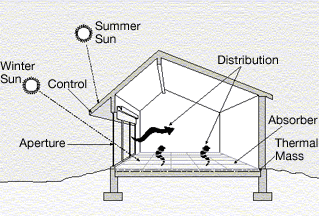We really shouldn’t underestimate the power of passive solar energy.
Not only is it usually less expensive to harness, but passive solar may be able to do more for you than those solar electric panels you’ve been drooling over.
So what is passive solar energy?
It is the solar energy you harness with home design, home orientation, and regular building materials. No additional mechanical equipment is required.
Sound simple? In many ways it is. This is part of the beauty of passive solar. No space age equipment or understanding of volts and amps is necessary. In fact people have been taking advantage of passive solar for over 2500 years.
Back then the Greeks planned entire cities to give each home access to the sun in the winter months.
The homes would be open to the south where the sun shone and they would have more protection in the north to keep out the cold winds.
The fundamentals haven’t really changed in the last few thousand years. The basic idea for harnessing passive solar is much the same today.
It breaks down something like this:
- Put a lot of windows on the south side of the building
- Don’t put many windows on the north side of the building
- Incorporate materials like stone and concrete that will absorb the sun’s energy and release it after the sun goes down
(The diagram below should make this a little more clear.)

The only thing that has changed since the time of the ancient Greeks is the material used to capture the sun’s energy.
Things like low-emissivity windows and more effective insulation have made things a little easier.
If you plan on incorporating passive solar power into your house plan you’ll want to know about:
– Isolated gain
– Direct gain
Isolated gain refers to the use of a sunroom or other area which is specifically designed for passive solar collection.
Direct gain is a little simpler in that it doesn’t involve any special construction. It usually just involves having south facing windows and masonry walls or floors to absorb the solar energy.
There are a few other terms you should be familiar with as well. An “aperture” is another word for a collector and usually refers to the window that lets the sun into the house.
An “absorber” is something that absorbs the sunlight as heat like the stone and concrete we mentioned previously. “Thermal mass” is similar to an absorber but it is actually the unexposed material below the absorber.
If you have the right piece of land and live in a moderate climate you could meet all your heating needs with passive solar.
Even if this isn’t possible for you, incorporating passive solar energy into your home design could save you money on your heating and cooling bills and make your home a lot more comfortable.
For more information check out our passive solar power interview with expert Stephan Tanner.
